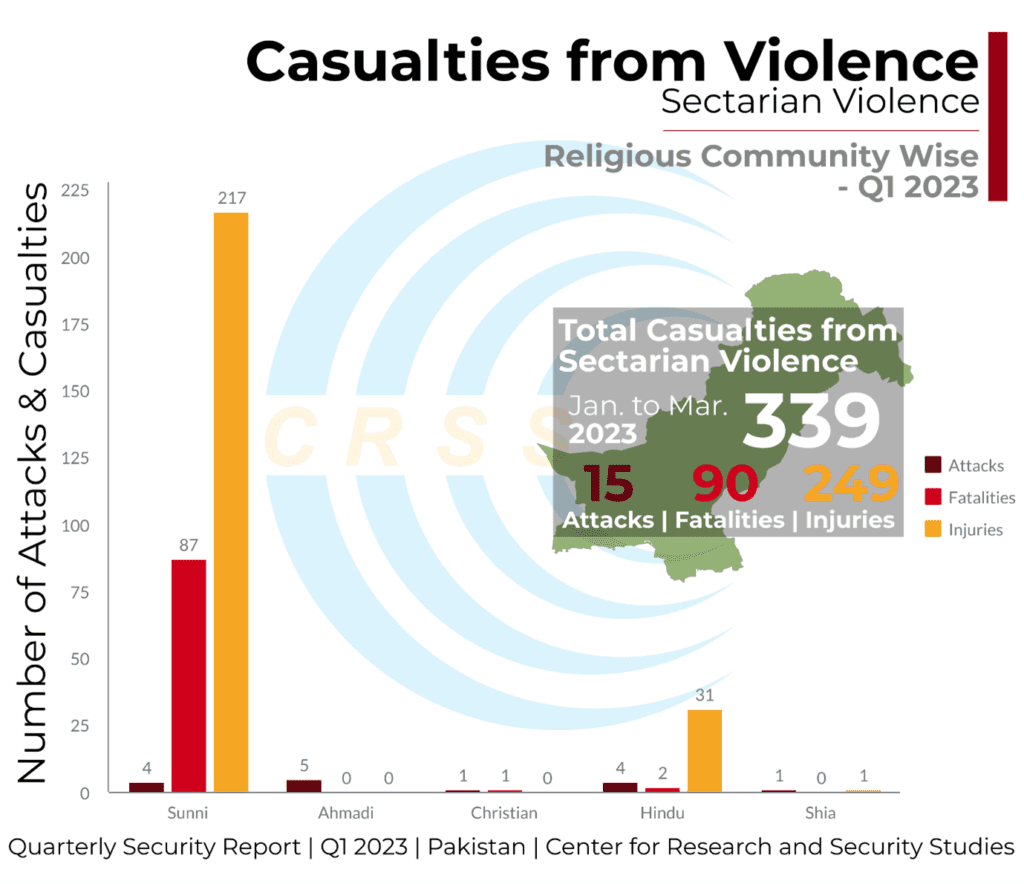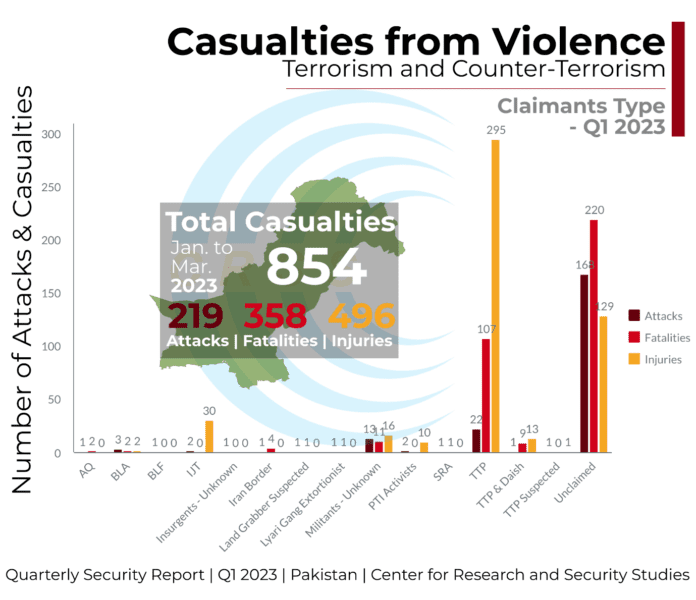During the first quarter of 2023, some 358 people lost their lives and 496 suffered injuries from as many as 219 terrorist attacks and counter-terror operations. The majority of the fatal victims of violence – about 86% – were from Khyber Pakhtunkhwa (KP) and Balochistan, with 68% (245) from the former and 18% (64) from the latter, followed by Sindh, Punjab and Islamabad in order of number of casualties recorded (Table 1).
The data shows some alarming trends in the initial three months of this year:
- The number of casualties recorded in the first quarter of 2023 (854) make up almost half of the casualties witnessed during the entire preceding year (1730); as per Center’s Annual Security Report 2022.
- The year 2023 started with the most fatal January for security forces in a decade, following a similar trend from the previous year which ended the same way, with the decade’s deadliest December for them.
- January 2023 was also one of the bloodiest months on record for Pakistan. With a death toll of 111, it recorded the second-highest number of fatalities of security personnel in a single month, second only to July 2014 with 118 fatalities.
These trends about Pakistan’s likeliness to endure more violence in 2023 were predicted in the Center’s Annual Security Report 2022.

Comparative Fatalities from Violence
By Type of Victims | Q1 2022 vs Q1 2023 | 2013 TO 2023
The violence-related fatalities of civilians in the first quarter of 2023 significantly declined compared to the same quarter last year, with 63 fatalities recorded as opposed to 136; marking a considerable reduction from the previous year.
There were 128 fatalities of militants and insurgents as a whole, marking a nominal increase from the same quarter last year where 120 fatalities were recorded. However, in the breakdown, the number of fatalities of insurgents alone decreased from 43 in the same quarter last year to 18 in the reporting quarter this year. Most concerningly, the fatalities of security and government officials almost doubled, from 88 in Q1 2022 to 167 in Q1 this year (Table 2).


As reported above, the year 2023 began no differently than how 2022 ended, with deadliest January for security forces in a decade. This followed a trend from the previous year which ended with decade’s most fatal December for them. With a death toll of 111, January 2023 also recorded the second-highest number of fatalities of security personnel in a single month, surpassed only by July 2014 with 118 fatalities.
The data indicates an extremely concerning trend as the first quarter of 2023 alone has witnessed 165 security personnel fatalities and if this persists throughout the year, their total life losses could be three times higher than the previous year.
Moreover, looking at the data for each month across the years; 2013 through the end of Q1 2023, we find some interesting and consistent patterns regarding high and low numbers of fatalities. For instance, the months of January, May, June and July have recorded relatively high numbers of fatalities throughout the years, while December tends to have relatively low numbers (Table 03).


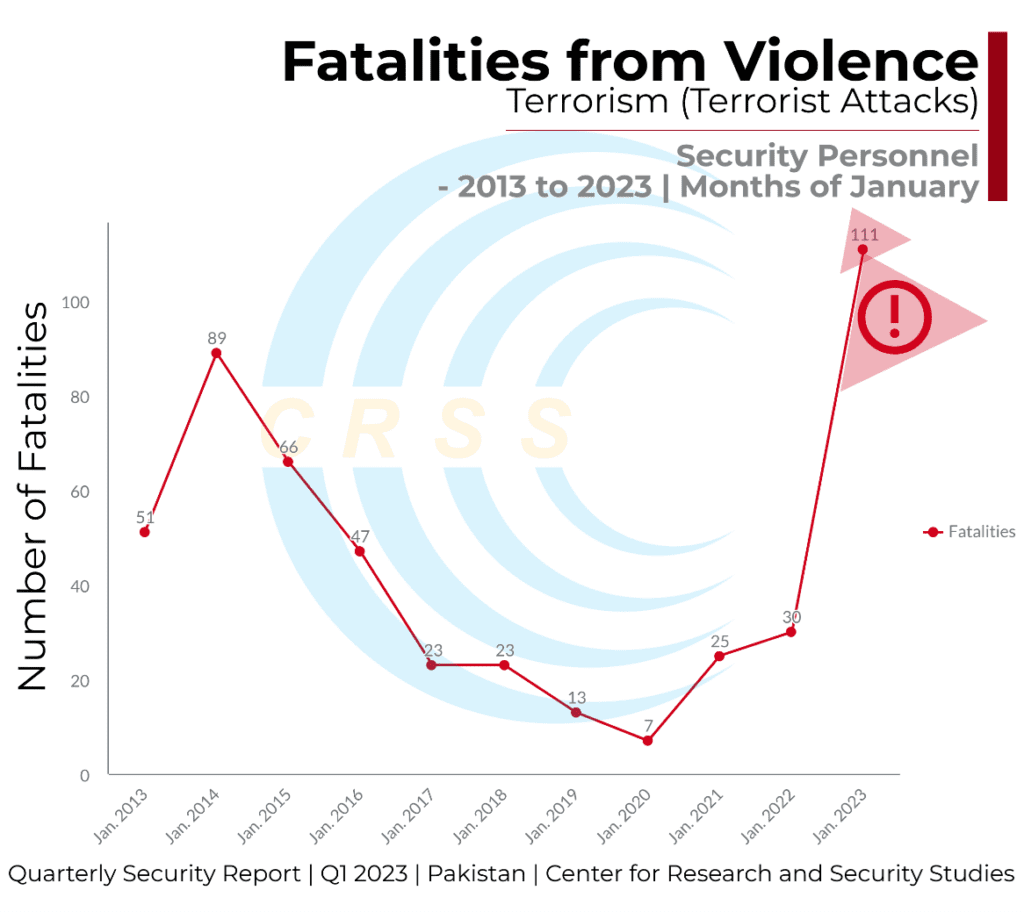
Casualties from Violence
By Type of Victims | Q1 2023
The terrorist attacks against security personnel, government officials, and civilians account for the majority of the incidents of violence and counter-violence that took place in the first quarter of 2023. While security forces and civilians were the primary victims of these incidents, the outlaws suffered the least from counter-terror operations, especially in terms of their number of casualties (Table 4).
Among the attacks on government and security properties, there were four explosions that damaged railway tracks, two attacks on policemen’s residence, eight attacks on a police post and four attacks on police vans.


Fatalities from Violence
By Districts
The highest increase in the violence-related fatalities – between Q1 2022 and Q1 2023 – was recorded in Peshawar. Other districts that show a notable increase in fatalities include Lakki Marwat, South Waziristan, Karachi, D.I. Khan, Kachchi, Bannu, Charsadda, and Barkhan. Kech, Bajaur, and Dera Bugti districts saw a significant dip in fatalities from Q1 2022 to Q1 2023.
Some districts had no fatalities in Q1 2022 but had one or more fatalities in Q1 2023, such as Bahawalnagar, Chaghi, Chinniot, Dir, Gujranwala, Hangu, Islamabad, Jacobabad, Larkana, Lasbela, Narowal, Naseerabad, Nausheroferoze, Orakzai, Sheikhupura, Sukkur, Swat, and Tando Allahyar. It reflects how violence continues shifting its location based on the situation and strategy of the militants (Table 05).

Casualties from Violence
Claimed by Militants
The Tehreek-e-Taliban Pakistan (TTP) became highly active in the country after unilaterally declaring the end of ceasefire. They carried out at least 22 attacks – causing 107 fatalities and at 295 injuries – beside an attack that was also claimed by Daish. One attack was suspected to have the imprint of the TTP, though the group did not claim any responsibility for it. Al-Qaeda also carried out one attack. Three insurgent groups, BLA, BLF, and SRA, also claimed responsibility for attacks, but the number of casualties in the incidents was very nominal (Table 06).


Casualties from Violence
Militants and Insurgents – By Affiliation
The majority of the counter-terror operations that took place in this quarter targeted TTP and unknown militants, with 15 against the former and 19 against the latter; militants whose identity was not declared, while the victims of five operations against the insurgents also remained unidentified. A commander of Hizbul Mujahideen (HuM), who was declared as most wanted by India, was gunned down in Rawalpindi on February 21, 2023. On 28 February 2023, an educationist Syed Khalid Raza was gunned down near his Gulistan-i-Jauhar home. He was a former activist of Islami Jamiat-i-Talaba and also had ties with Al-Badr, the group involved in the armed struggle in India-held Kashmir. The Sindhudesh Revolutionary Army (SRA) claimed responsibility for this attack (Table 07).

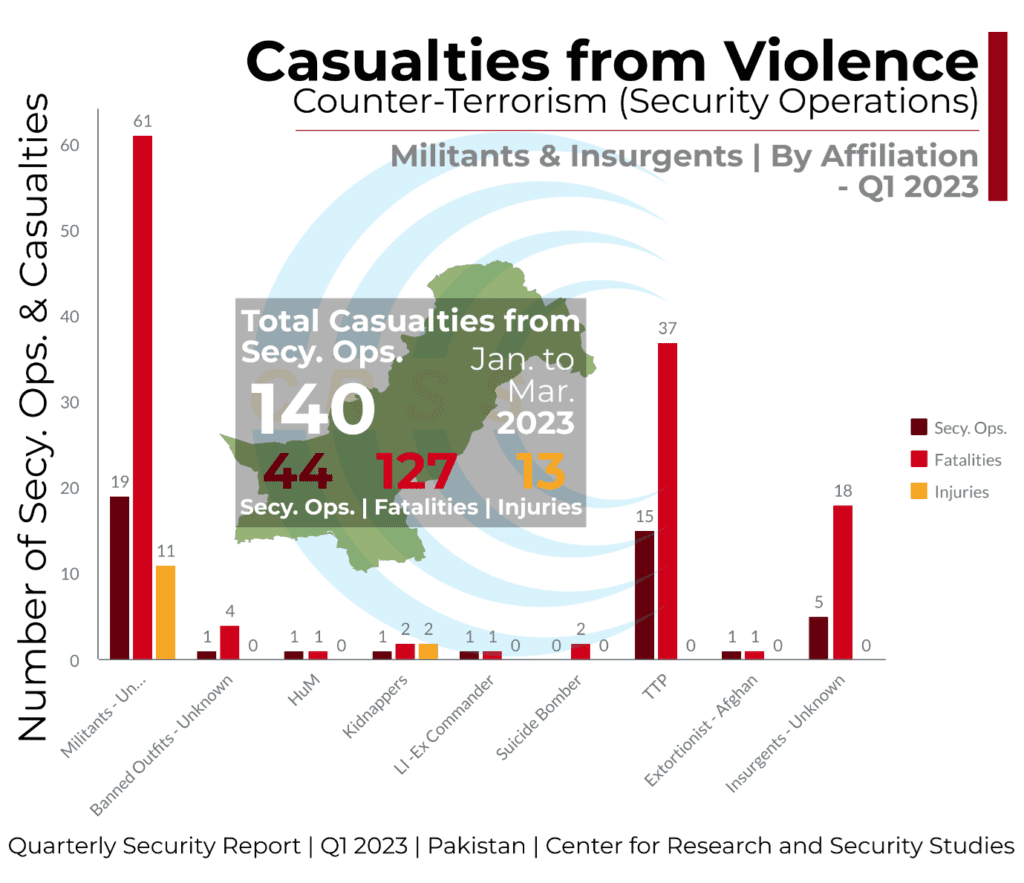
Sabotage Activities by Outlaws
Sabotage incidents have suddenly upsurged in the country, where the data collected in Q1 2023 recorded 57 attacks that were conducted by the militants, insurgents, civilians, and political activists as well. Most of the sabotage activities were carried out by unidentified outlaws, with the exception of four incidents that were claimed by TTP, BLA and BLF. Furthermore, five incidents of sabotage were committed by the unknown religious zealots against Ahmadi worship places in the country. The outraged activists of the PTI ransacked 21 police vans during the political unrest surrounding the arrest of former prime minister, Imran Khan. Table 8 below shows the details of properties that were damaged during the sabotage attacks in the country.
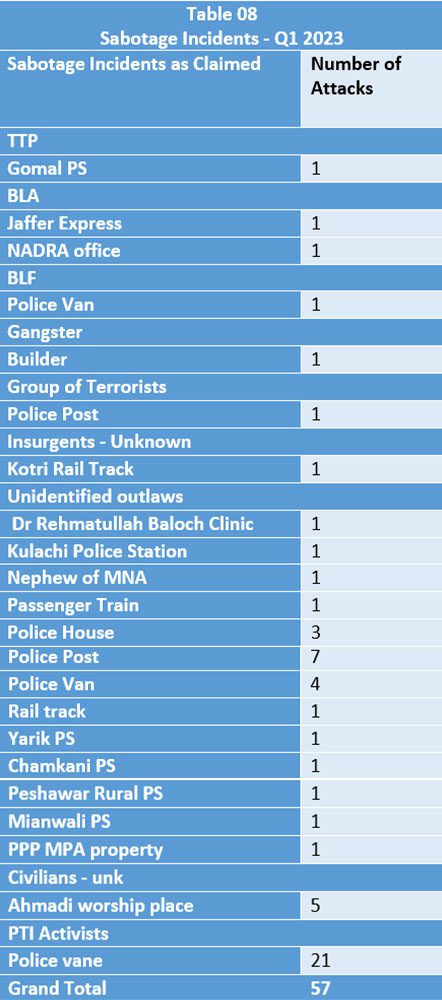
Casualties from Sectarian Violence
The start of 2023 has been marked by a significant rise in sectarian violence where the majority of victims (304 out of the 339 total sectarian violence related casualties) belonged to the Sunni Muslim community. In this regard, the deadliest single incident occurred at a Sunni Mosque, which claimed the lives of 84 people and caused 217 injuries. The victims in the attack had multiple identities – they were Sunni Muslims working as police officials who were being targeted regularly by TTP these days.
Other religious communities were also targeted, with four attacks against the Hindu community resulting in two fatalities and 31 injuries. These attacks were motivated by the hatred against the celebration of Holi festivals at Punjab University and Karachi University – leaving at least 15 students injured at each university. When the terrorists attacked the Karachi Police Office, a Christian employee also lost his life. The Ahmadi and Shia communities also experienced attacks, five and one respectively.
However, the Ahmadi community had not reported any casualties as the attacks were carried out against their worship places. The Shia community only suffered one injury as a renowned Noha Khuwan, Asad Agha, was shot by some unidentified men on the Super Highway on January 14, 2023.
These statistics underscore the continuing threat of sectarian violence in Pakistan, which requires immediate measures to address the underlying causes of this violence (Table 09).

